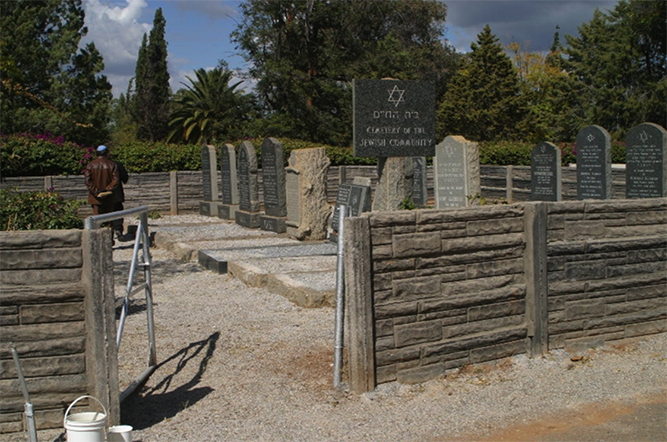 Exterior View (2005), 15” x 11” Watercolor, Jay A. Waronker
Exterior View (2005), 15” x 11” Watercolor, Jay A. Waronker
ZIMBABWE
Jewish Cemetery |
|
|
In the first quarter of the twentieth century, a Jewish cemetery was established in Gweru on a flat parcel out land outside the center of town. As a result of a community of Jews of both Eastern and Western European origins settled in Gweru beginning in the early twentieth century, a cemetery came to be needed. During the 1950s and 60s, when the Jewish population in Gweru was at its height, dozens of Jews who spent their years living productive and happy lives in the town came to be buried here.
The small and pleasant cemetery, with its solid perimeter wall, small entry gate, and gravel ground covering, is arranged in neat rows. In the Jewish tradition, the graves are oriented in a way that the headstones face Jerusalem. The tall headstones, fabricated in a variety of shapes and designs, are made of granite and inscribed in a combination of Hebrew and English. Surrounding the cemetery is a variety of large native shade trees and vegetation. These provide a pleasant sense of place and isolation.
After independence from Great Britain in 1980, the uncertainty of a newly-established Zimbabwe, subsequent civil unrest, pronounced economic decline beginning in the mid-1980s, and the less-than-ideal social climate particularly for white citizens under the government of President Robert Mugabe, Zimbabwe’s Jewish population steadily declined during the last years of the twentieth century. By the new millennium, only a few hundred Jews remained in the country. The majority of the Jewish community emigrated to South Africa, Australia, England, Canada, or the United States. Gweru along with nearby Kadoma and Kwekwe as well as Mutare in eastern Zimbabwe were particularly affected by this change, and eventually only a handful of Jews remained in these small cities. As a result, the cemetery saw less action.
In 2000, Kweke’s small synagogue was sold by the Jews to the Pentecostal Assembly Church. Since then it has served this black African Christian community. The last local Jew, a Mr. Levitas, died in 2003 and was buried in this cemetery, ending a period of Jewish life in this community that spanned more than a century.
When Jay A. Waronker, the artist of the watercolor renderings on this site, was in Gweru for one night to document the former synagogue in 2005 as a Fulbright Scholar, he was approached by plain-clothed police officers just after finishing his work, questioned in hostile fashion why he was in town and photographing sensitive buildings in the neighborhood, his passport and camera were confiscated, and he was taken to the police station where he was threatened with incarceration. Finally free to go yet without his personal property, Waronker was able to telephone the US Embassy in Harare from his hotel. After many hours of waiting on that Saturday afternoon, and through the intervention of the embassy staff, he returned to the police station, met with the chief of police, given back his camera and passport without apology, and was forced to spend another night in that unfortunate environment. Early the next morning on the first bus available at a time when the country was afflicted by an acute gasoline shortage, Waronker left the city that had been so unhospitable to him. He left without being able to document the Gweru Jewish cemetery, which during the last decade has been maintained as best as possible. In recent years this cemetery, after some years of less-than-ideal maintenance, was nicely renovated with the support of regional Jewish agencies and donors who had some familial connection to the site.
